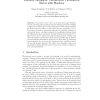Free Online Productivity Tools
i2Speak
i2Symbol
i2OCR
iTex2Img
iWeb2Print
iWeb2Shot
i2Type
iPdf2Split
iPdf2Merge
i2Bopomofo
i2Arabic
i2Style
i2Image
i2PDF
iLatex2Rtf
Sci2ools
ECCV
2010
Springer
2010
Springer
Visibility Subspaces: Uncalibrated Photometric Stereo with Shadows
Photometric stereo relies on inverting the image formation process, and doing this accurately requires reasoning about the visibility of light sources with respect to each image point. While simple heuristics for shadow detection suffice in some cases, they are susceptible to error. This paper presents an alternative approach for handling visibility in photometric stereo, one that is suitable for uncalibrated settings where the light directions are not known. A surface imaged under a finite set of light sources can be divided into regions having uniform visibility, and when the surface is Lambertian, these regions generally map to distinct three-dimensional illumination subspaces. We show that by identifying these subspaces, we can locate the regions and their visibilities, and in the process identify shadows. The result is an automatic method for uncalibrated Lambertian photometric stereo in the presence of shadows, both cast and attached.
| Added | 02 Jul 2010 |
| Updated | 02 Jul 2010 |
| Type | Conference |
| Year | 2010 |
| Where | ECCV |
Comments (0)

